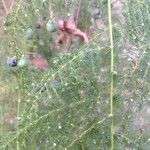Climbing shrub to 8 m high; branches branching to 4 orders, terete or grooved, with spines 2– 3 mm long mainly on the main branches, glabrous.. Cladodes arranged in ± one plane, in fascicles of 4– 25, linear, fine, 3– 6(– 10) mm long.. Flowers solitary or fasciculate, 2– 3 together on terminal branches; bracts minute, falling more or less quickly; pedicels 4– 8 mm long, articulated at the middle or below.. Tepals white, ± equal, ± 3 mm long; stamens shorter than the perianth; anthers yellow; ovary 3-locular with 6– 8 ovules in each locule; style ± 1 mm long, 3-branched.. Berry red, 6– 8(– 10) mm in diameter, 1– 3-seeded.. Seeds black.. Fig. 1: 4– 6 (page 7).
Herbs hermaphroditic. Stems climbing, much branched, to several meters, slightly woody near base; branches spreading horizontally, with branchlets and cladodes arranged in 1 plane, frondlike. Cladodes in fascicles of 10--13, 4--5 mm, very slender, slightly trigonous. Leaf spur short, occasionally spinescent on main stems. Inflorescences developing after cladodes. Flowers solitary or in clusters of 2 or 3; pedicel short, articulate at middle. Perianth white; segments widely spreading, lanceolate-oblong, ca. 7 mm. Berry purplish black, 6--7 mm in diam., 1--3-seeded. Fl. Jun. 2 n = 20*.
Vines, woody, scrambling or climbing to 5 m; roots fibrous. Stems to 4 m, wiry, smooth, branches planate; cladophylls in fascicles of (5–)8–20 per node, filiform, 4–10 × 0.5 mm, ± rigid, with single vein. Leaves membranous, 1–2 mm; blade forming short spine with reflexed apex, base hardened. Inflorescences terminally umbellate, 1–4-flowered. Flowers bisexual, nodding; perianth spreading, campanulate; tepals white, 3–4 × 1–1.5 mm; pedicel 1–3 mm, jointed at or just above base. Berries purplish black, 4–5 mm. Seeds 1–3. 2n = 20.
Slender, scrambling or climbing perennial. Stems to 2 m long, ± woody below, green and much-branched above; branches widely spreading with branchlets and cladodes all lying in one plane. Scale-leaves scarious, entire, basal spur to 2.5 mm long, grey-brown, finely pointed, reflexed. Cladodes needle-like, extremely fine, 3-7 mm long, 7-20 at each node. Flowers terminal, 1-4, white. Berry globose, ± 6 mm diam., purple-black. Seeds 1-3, ± 3 mm diam., globose, black.
Erect or usually scandent, spiny shrub, up to 2 m high. Stems wiry, smooth, with many spreading, twining branches. Spines short, hard, few basally, absent above. Cladodes many in fascicles, filiform, soft, shiny, up to 15 mm long, arranged in horizontal plane. Flowers solitary on an apical disc; stamens with yellow anthers; pedicels short, articulated below middle. Flowering time Oct.-May. Fruit a black berry.
Evergreen, perennial, usually scandent shrub, up to 5 m high. Roots main ones swollen in young plants. Stems not ribbed when young, not zigzagging. Spines few, short, basal. Cladode fascicles globose, cladodes 4-7(-12) mm long. Flowers: solitary in centre of apical cladode fascicle, tepals white; Nov.-Mar. Fruit a berry.
An evergreen vine. It is twining or trailing. It has strong thorns. The stems are wiry and it climbs 2 m high. The leaves are small and flat and arranged like a feather. The flowers are small and white. They are 3 mm long. The fruit are red to black berries. They have 1-3 seeds.
Evergreen, perennial, erect or scandent herb, up to 2 m high. Main roots swollen in young plants. Cladode fascicles globose, cladodes 4-7(-12) mm long. Flowers solitary in centre of apical cladode fascicle, white.
Spiny climbing shrub to 2 m, stems spiny only at base. Cladodes numerous in fascicles, filiform. Flower solitary on an apical disc, tepals and filaments spreading.






